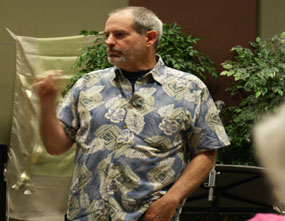Retro-what?*
Before you think I’ve lost my mind, please notice that the word answer was not capitalized. Retronym is not the Answer. Rather, in some ways it is the question.
But first, let me tell you a bit about a retronym. It is, come to find out, a term that traces its first usage to 1980. You can’t find it in many dictionaries, apparently, and I only know of it through a marketing brochure that came to us as a pitch to subscribe to a copyediting newsletter. Even then, it is not defined, per se, except by context and example. A retronym can be a single word, or more than one word.
What caught my eye, in the article’s examples, was that two of them were Christian in origin, and both are commonly used – Before Christ (BC) and Old Testament. Figured it out yet? How about this one: acoustic guitar. Two more, which often are used in the same sentence: landline and cel phone (or is it cell phone? Have we solved that one yet?).
OK, enough. A retronynm is a term that is coined to distinguish the original from a new version. Hence the need for Old Testament when the New Testament arrived, or acoustic guitar after the invention of the electric guitar.
The article made me think. Is traditional worship a retronym? Actually, given the speed at which stylistic identifiers are being pasted on church gatherings, is contemporary worship a retronym? I’ll go one further, at the risk of being misunderstood: is God-centered worship a retronym?
As Bob Dylan sang long ago, “I can’t think for you, you’ll have to decide…” but I wonder if, in our attempt to be precise about what we in music and worship leadership are supposed to be able to do, we’ve lost track of who we’re supposed to serve. I hear so many stories of arts leadership being frustrated at having to “please the pastor,” or the elders, or the finance committee, or the biggest giver, or the loudest complainer. To be called into the ministry of worship leadership these days seems to be a long hard road to hoe.
Is children’s music ministry a retronym? Time will tell, but it seems that many children’s music leaders have begun to integrate other arts into their ministries, so that the question has moved from “Should we use tracks or a live accompanist?” to “Is music the only or the best art to communicate the message of this text?”
We have lost a generation of participating musicians to our churches by abandoning youth choirs in years past. Fortunately youth choirs are in resurgence, but that is due, in part, to the fact that children’s music leadership stayed the course when it might have been easier to just give up. From the standpoint of congregational participation in worship, it is much easier to build from the chronological “bottom” rather than impose from the chronological “top.” Show me a church where the children sing, or participate in worship expression through one or more of the arts – all of the children – and I’ll show you leadership that is doing kingdom building.
In times of economic uncertainty, it is tempting to “cut back,” and children’s ministry is an easy target, because they often have no advocates. If you are in leadership, don’t abandon the children, or their music/arts programs. Your successors, and the churches they serve, will pay for it years into the future. Instead, when it comes to children’s music/arts ministry “pay it forward.” You’ll be planting seeds that will feed them and their children far into the future.
Don’t be a retronym. Don’t let it happen on your watch. The worship life of the church universal is at stake. Adapt. Cast a vision. Be an advocate. “Teach your children well….”
Today’s list: One Director’s choir’s Favorite Songs
I keep returning to these pieces, not only because I like them, but the kids ask for them. I think they all have very high quality texts, and the marriage of text and music is excellent. Ranges are also appropriate for children in that they are not too low. – Janice Hawthorne Timm (United Church, Cloverdale, California)
Advent and Christmas
Song of Zechariah – Hal Hopson (Harold Flammer FA5018) – Unison with keyboard accompaniment
Sans Day Carol – Z. Randall Stroope (Choristers Guild CGA549) – Two part with harp or piano accompaniment
The Angel Gabriel – arranged by John Raymond Howell (Boosey & Hawkes 6256) – Unison or two part with keyboard accompaniment
General
When I Turn My Heart to Heaven – Joseph Martin (Fred Bock Music BG2279) – Two part with keyboard accompaniment
O Praise the Lord, Who Made All Beauty – Hal Hopson (Choristers Guild CGA143) – Unison with keyboard accompaniment
Younger Children
And I Will Praise Him – Michael Jothen (Choristers Guild CGA303) – Unison with keyboard and percussion accompaniment
Seven Songs for the Church Year – Michael Bedford (Choristers Guild CGA693) – Unison with keyboard and bells or chimes (3-5 bells per song) accompaniment
*originally published as an editorial in the September/October 2008, issue of Creator magazine












{ 3 comments… read them below or add one }
Thanks, Vern! Those are all still favourites. And while I am not directing a choir down here (NZ), I am learning loads of worship music that is new to me, and working with amazing people.
Yikes. “Church Sound Guy” would clearly be retronymic!
If your point is “So much of what we do in church is retronymic: it’s an adaptation of something that’s gone before,” then a hearty “Amen!” To mix the metaphors, so much of what I hear in church are merely echos, not voices.
David-
Agreed…but my point was also that we are sometimes so (dare I write?) obsessed with labels in order to divide ourselves that we forget what we have in common…
You must log in to post a comment.